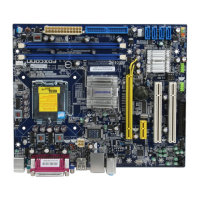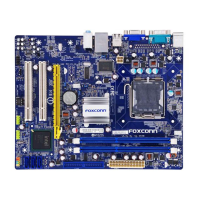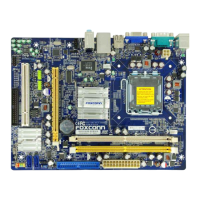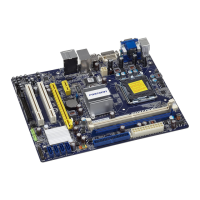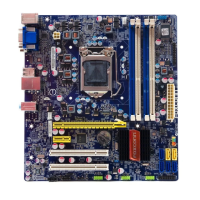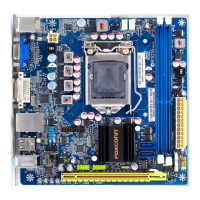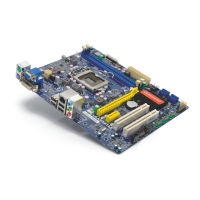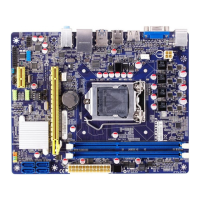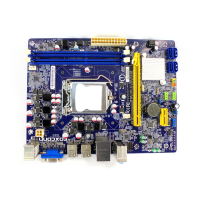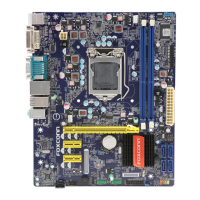Do you have a question about the Foxconn Inferno Katana and is the answer not in the manual?
Details motherboard specifications including CPU, chipset, memory, audio, LAN, and ports.
Illustrates the physical layout of motherboard components and connectors with numerical labels.
Describes the function and connection points of ports located on the motherboard's rear panel.
Provides step-by-step instructions for safely installing the CPU and its cooler onto the motherboard.
Guides on proper installation of DDR3 memory modules into the motherboard's DIMM sockets.
Instructions on how to install various expansion cards into PCI Express and PCI slots.
Details on connecting internal components like power connectors, USB headers, and audio headers.
Explains the function and configuration of jumpers on the motherboard for specific settings.
Describes the function of onboard buttons such as Power, Reset, and Clear CMOS.
Explains the purpose and function of onboard LEDs for system status indication.
Lists and explains BIOS debug codes for troubleshooting boot or hardware issues.
Instructions on how to access the BIOS setup utility during system startup.
Overview of the main BIOS setup interface and navigation options.
Displays current system configuration details like BIOS version, CPU, and memory.
Provides access to detailed BIOS settings for IDE, AHCI, and MPS configurations.
Allows configuration of North Bridge, South Bridge, and onboard device settings.
Settings for enabling/disabling USB functions, legacy support, and controller modes.
Options to configure boot device priority and other boot-related settings.
Configuration of ACPI states and power saving features for system performance.
Monitoring and control of system voltages, temperatures, and fan speeds.
Features related to CPU configuration, memory timing, voltage control, and overclocking.
Options for setting supervisor/user passwords and boot sector virus protection.
Resets BIOS settings to optimized default values for stable operation.
Saves current BIOS configuration changes and exits the setup utility.
Exits BIOS setup without saving any modifications made to the settings.
Overview of the utility CD contents, including drivers and software applications.
Details on using the Aegis Panel for system monitoring, OC, fan control, and alarm functions.
Guide to backing up, updating BIOS, drivers, and utilities via local or online methods.
Instructions for backing up, changing, and deleting the boot time logo image.
Information on using the FOX DMI viewer for system analysis and troubleshooting.
Explains the fundamental concepts of RAID, including mirroring, striping, and error correction.
Introduction to the Intel Matrix Storage Manager utility for configuring RAID arrays.
Step-by-step guide to creating a bootable RAID driver diskette for OS installation.
Instructions on configuring BIOS SATA mode to RAID or AHCI for RAID setup.
Detailed steps for creating RAID volumes (RAID0, RAID1, RAID5, RAID10) within the BIOS interface.
Guide on installing Windows XP, including RAID driver integration during setup.
Steps to integrate existing SATA hard disks into a new RAID system within Windows XP.
Overview of ATI CrossFireX technology for multi-GPU performance enhancement.
Instructions for installing and enabling ATI CrossFireX technology with compatible hardware.
Overview of NVIDIA SLI technology for multi-GPU performance enhancement.
Steps for installing dual SLI-ready graphics cards and enabling NVIDIA SLI technology.
Details motherboard specifications including CPU, chipset, memory, audio, LAN, and ports.
Illustrates the physical layout of motherboard components and connectors with numerical labels.
Describes the function and connection points of ports located on the motherboard's rear panel.
Provides step-by-step instructions for safely installing the CPU and its cooler onto the motherboard.
Guides on proper installation of DDR3 memory modules into the motherboard's DIMM sockets.
Instructions on how to install various expansion cards into PCI Express and PCI slots.
Details on connecting internal components like power connectors, USB headers, and audio headers.
Explains the function and configuration of jumpers on the motherboard for specific settings.
Describes the function of onboard buttons such as Power, Reset, and Clear CMOS.
Explains the purpose and function of onboard LEDs for system status indication.
Lists and explains BIOS debug codes for troubleshooting boot or hardware issues.
Instructions on how to access the BIOS setup utility during system startup.
Overview of the main BIOS setup interface and navigation options.
Displays current system configuration details like BIOS version, CPU, and memory.
Provides access to detailed BIOS settings for IDE, AHCI, and MPS configurations.
Allows configuration of North Bridge, South Bridge, and onboard device settings.
Settings for enabling/disabling USB functions, legacy support, and controller modes.
Options to configure boot device priority and other boot-related settings.
Configuration of ACPI states and power saving features for system performance.
Monitoring and control of system voltages, temperatures, and fan speeds.
Features related to CPU configuration, memory timing, voltage control, and overclocking.
Options for setting supervisor/user passwords and boot sector virus protection.
Resets BIOS settings to optimized default values for stable operation.
Saves current BIOS configuration changes and exits the setup utility.
Exits BIOS setup without saving any modifications made to the settings.
Overview of the utility CD contents, including drivers and software applications.
Details on using the Aegis Panel for system monitoring, OC, fan control, and alarm functions.
Guide to backing up, updating BIOS, drivers, and utilities via local or online methods.
Instructions for backing up, changing, and deleting the boot time logo image.
Information on using the FOX DMI viewer for system analysis and troubleshooting.
Explains the fundamental concepts of RAID, including mirroring, striping, and error correction.
Introduction to the Intel Matrix Storage Manager utility for configuring RAID arrays.
Step-by-step guide to creating a bootable RAID driver diskette for OS installation.
Instructions on configuring BIOS SATA mode to RAID or AHCI for RAID setup.
Detailed steps for creating RAID volumes (RAID0, RAID1, RAID5, RAID10) within the BIOS interface.
Guide on installing Windows XP, including RAID driver integration during setup.
Steps to integrate existing SATA hard disks into a new RAID system within Windows XP.
Overview of ATI CrossFireX technology for multi-GPU performance enhancement.
Instructions for installing and enabling ATI CrossFireX technology with compatible hardware.
Overview of NVIDIA SLI technology for multi-GPU performance enhancement.
Steps for installing dual SLI-ready graphics cards and enabling NVIDIA SLI technology.
| Number of memory slots | 4 |
|---|---|
| Maximum internal memory | 16 GB |
| Processor socket | LGA 1156 (Socket H) |
| Processor manufacturer | Intel |
| Maximum number of SMP processors | 1 |
| S/PDIF out connector | Yes |
| Number of SATA connectors | 6 |
| eSATA ports quantity | 2 |
| USB 2.0 ports quantity | 8 |
| VGA (D-Sub) ports quantity | 0 |
| Audio output channels | 7.1 channels |
| Motherboard form factor | ATX |
| PCI Express x16 slots | 3 |
| Controller 2nd interface type | IDE/SATA2/eSATA |
| BIOS memory size | 64 Mbit |
